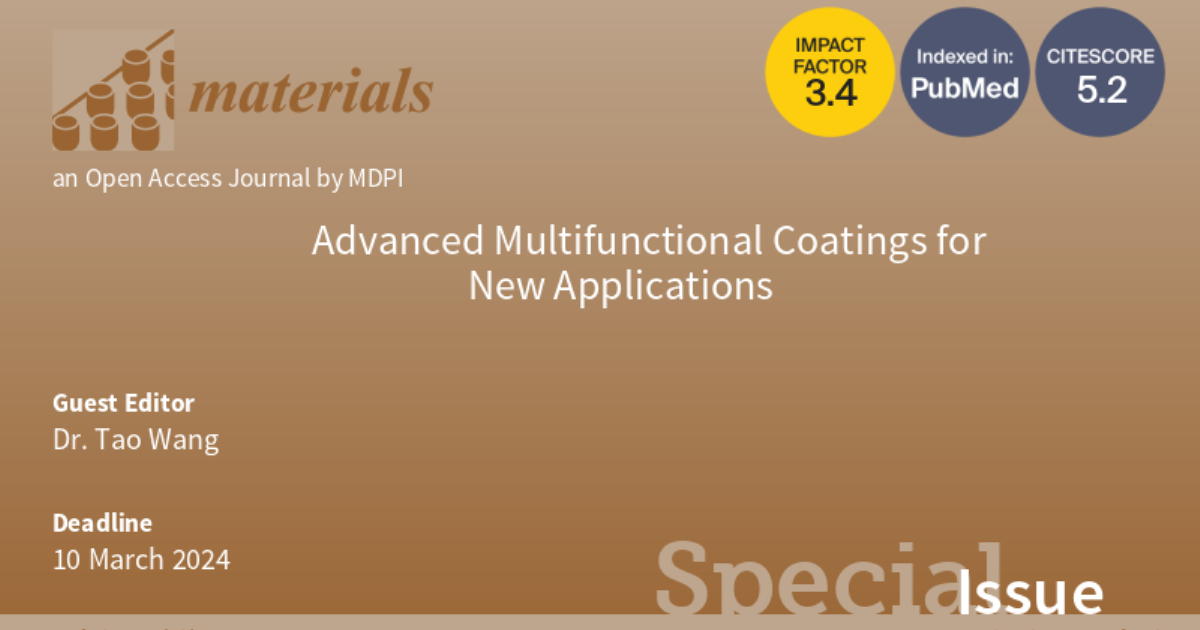Advanced Multifunctional Coatings for New Applications
A special issue of Materials (ISSN 1996-1944). This special issue belongs to the section "Thin Films and Interfaces".
Deadline for manuscript submissions: 20 September 2024 | Viewed by 12002

Special Issue Editor
Special Issue Information
Dear Colleagues,
Coating and surface engineering play important roles in the development of industry and society. The performance of critical raw materials has been improved in many conventional and industrial areas. With the emergence of newly developing fields, e.g., ultraprecision tools, biomedical devices, and marine instruments, coatings with remarkable functional properties are in high demand. For example, high hardness and a low friction coefficient are necessary for tool coatings. Biomedical implants require chemical inertness, biocompatibility, and antibacterial efficiency. Moreover, corrosion-resistant coatings and biofilm adhesion are needed for marine instruments.
Notably, physical vapor deposition (PVD) and chemical vapor deposition (CVD) processes, which are often used for hard (ceramic) coatings, suffer from poor nucleation and lack adhesion. These issues arise from the incompatibility of the substrate material and the coating system. Therefore, key issues for coating systems concern nucleation, growth, and the adhesion of the coating to substrates and, concomitantly, implementing deposition procedure strategies that enable the multifunctionality of the coating, i.e., by tailoring the topography (roughness) and electrical conductivity. Facile and economically viable coating deposition processes combined with excellent adhesion, resistance, and multifunctionality will improve current industrial processes and enable novel applications in the future.
This Special Issue aims to address the latest trends in advanced coatings and surface engineering. The coating technology and excellent properties are highlighted with a focus on applications in various fields, including, but not limited to, precision machining, sensors, implants, electronics, and marine instruments.
Dr. Tao Wang
Guest Editor
Manuscript Submission Information
Manuscripts should be submitted online at www.mdpi.com by registering and logging in to this website. Once you are registered, click here to go to the submission form. Manuscripts can be submitted until the deadline. All submissions that pass pre-check are peer-reviewed. Accepted papers will be published continuously in the journal (as soon as accepted) and will be listed together on the special issue website. Research articles, review articles as well as short communications are invited. For planned papers, a title and short abstract (about 100 words) can be sent to the Editorial Office for announcement on this website.
Submitted manuscripts should not have been published previously, nor be under consideration for publication elsewhere (except conference proceedings papers). All manuscripts are thoroughly refereed through a single-blind peer-review process. A guide for authors and other relevant information for submission of manuscripts is available on the Instructions for Authors page. Materials is an international peer-reviewed open access semimonthly journal published by MDPI.
Please visit the Instructions for Authors page before submitting a manuscript. The Article Processing Charge (APC) for publication in this open access journal is 2600 CHF (Swiss Francs). Submitted papers should be well formatted and use good English. Authors may use MDPI's English editing service prior to publication or during author revisions.
Keywords
- thin films
- micro/nanostructured surfaces
- nucleation and film growth
- protective coatings
- wear and friction
- anti-corrosion
- anti-biofouling
- electrical and electrochemical properties
- superhydrophobic
- film and coating characterization






